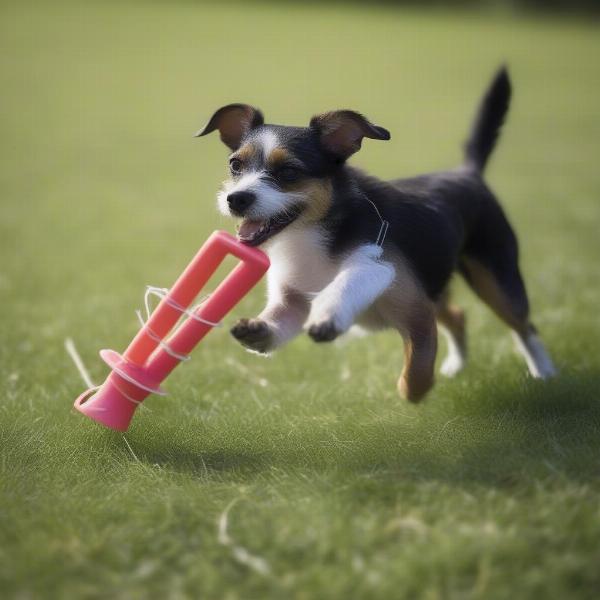Dog dummies are essential tools for training hunting dogs, and increasingly, for engaging companion dogs in enriching activities. They mimic the size, shape, and sometimes even the scent of game, allowing you to practice retrieving exercises without live animals. Whether you’re preparing your retriever for the field or simply want to tire out your energetic pup, dog dummies are a valuable asset. This guide covers everything you need to know about choosing and using dog dummies for effective training.
Choosing the Right Dog Dummy for Your Needs
Selecting the appropriate dummy depends on your dog’s breed, age, and training goals. Puppies and smaller breeds benefit from lightweight canvas dummies, while experienced retrievers might require heavier dummies that simulate the weight of a real bird. Consider the following factors:
- Material: Canvas dummies are durable and easy to clean, making them ideal for beginners. Plastic dummies are more resistant to punctures and can be filled with water for added weight. Fur-covered dummies offer a more realistic feel for advanced training.
- Size and Weight: Start with smaller, lighter dummies for puppies and gradually increase the size and weight as they progress. Heavier dummies can help build strength and endurance in adult dogs.
- Shape: Dummies are available in various shapes, from standard cylinders to realistic bird replicas. The shape you choose can influence your dog’s grip and retrieving technique.
- Scent: Some dummies can be scented with game bird scent to further enhance the training experience, making it more engaging and realistic for your dog.
Using Dog Dummies Effectively in Training
Effective dummy training involves a gradual progression, starting with simple retrieves and advancing to more complex scenarios. Here are some key steps:
- Introduction: Introduce the dummy as a toy, encouraging your dog to play with it and develop a positive association.
- Short Retrieves: Begin with short retrieves on flat ground, using positive reinforcement to reward successful retrieves.
- Increasing Distance: Gradually increase the distance of the retrieves as your dog’s skills improve.
- Varying Terrain: Introduce varied terrain, such as tall grass or water, to challenge your dog and build their confidence.
- Multiple Dummies: Use multiple dummies to practice marking, which involves the dog remembering the location of several fallen dummies.
- Blind Retrieves: Introduce blind retrieves, where the dog must retrieve a dummy they haven’t seen fall. This requires trust and strong communication between handler and dog.
Dog Dummies for Non-Hunting Breeds
 Small dog playing with canvas dummy
Small dog playing with canvas dummy
Even if your dog isn’t a hunting breed, dog dummies can still provide valuable exercise and mental stimulation. Retrieving is a natural instinct for many dogs, and dummies offer a safe and convenient way to satisfy this drive. They can also be used for interactive games like fetch and tug-of-war, promoting bonding and burning off excess energy.
“Dog dummies are a fantastic tool for engaging dogs of all breeds in enriching activities,” says Dr. Emily Carter, a certified veterinary behaviorist. “They provide mental stimulation, physical exercise, and can even help address behavioral issues related to boredom or frustration.”
Conclusion
Dog dummies are a versatile training tool for dogs of all breeds and ages. By understanding the different types of dummies available and utilizing effective training techniques, you can unlock your dog’s retrieving potential and provide them with a fun and rewarding activity. Whether you’re training for the field or simply looking for a way to enrich your dog’s life, dog dummies offer a valuable resource.
FAQ
- What is the best material for a dog dummy? The best material depends on your dog’s age and experience. Canvas is good for beginners, while plastic or fur-covered dummies are suitable for more advanced training.
- How do I introduce a dummy to my puppy? Let your puppy play with the dummy as a toy first, building a positive association before starting formal retrieving exercises.
- Can I use dog dummies for non-hunting breeds? Yes, dog dummies can provide valuable exercise and mental stimulation for all breeds.
- What is a blind retrieve? A blind retrieve is when the dog must retrieve a dummy they haven’t seen fall, relying on your directions.
- Where can I buy dog dummies? Dog dummies are available at most pet supply stores and online retailers.
Related Articles on ILM Dog
ILM Dog is your trusted international resource for all things dog-related. From breed selection and health advice to training tips and product recommendations, we’re dedicated to helping you provide the best possible care for your canine companion. Our expertise covers all aspects of dog care, including training, nutrition, and grooming. For expert advice, contact us via email at [email protected] or phone at +44 20-3965-8624. ILM Dog is here to support you every step of the way.